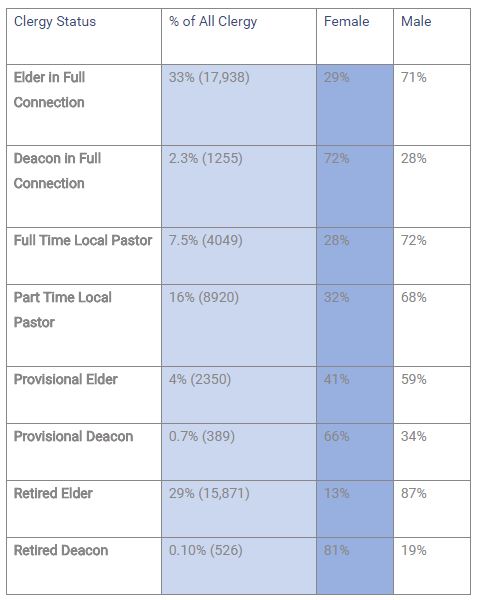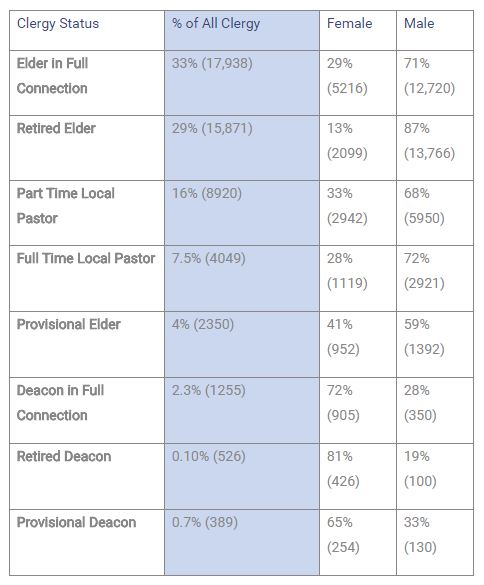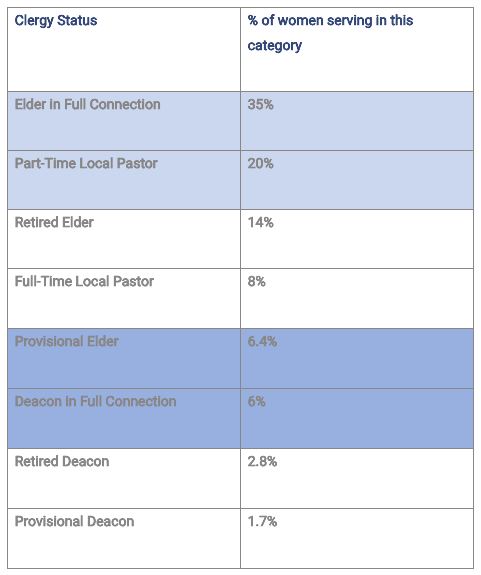Who are the United Methodist clergy in 2014 and what might this mean for the future of the denomination? GCSRW looked at the 2014 statistics of United Methodist clergy and compared them to statistics from previous years. We then compared these numbers to those in the Lewis Center’s Clergy Age Trends in The United Methodist Church report, and illustrate below what the future of United Methodist clergy may look like if current trends continue, and what this means for the role of women among clergy in the denomination. Our findings illustrate that the number of female clergy is increasing but at a slower rate compared to 1992 and 2002. United Methodist clergy are getting older, with fewer young people coming up through the process to replace an aging population.
Chart A
Clergy Status Breakdown

*(Total number in Chart A is 51,298, or 92.6%, of entire clergy population. Other categories bring total to 54,262)
Chart B
Clergy Status Breakdown (in Ranked Order)

United Methodist Clergy by the numbers
The 2014 statistics (Chart A) show that, of the 54,262* United Methodist clergy, 27% are women and 73% are male. The total number of clergy (retired and active) increased from 44,979 in 2006 and 44,926 in 2011. The number of female clergy is up from 11% in 1992, 19% in 2002, and 25% in 2013.
In Chart B, overall most clergy serve as elders in full connection (33%). Retired elders make up 29% and part-time local pastors make up 16%. Among woman, the highest percentage serve as deacons (72% of all deacons are women) or retired deacons (81% of retired deacons are women), with the second largest number of women serving as part-time local pastors (32%) and then elders in full connection (29%).
The largest number of clergymen are retired elders at 87%, with full-time local pastors (72%) and elders in full connection (71%) a close second and almost equal in number. There are more active women elders (29%) than retired elders (13%), the highest number of active female elders in history.
United Methodist Clergywomen by the Numbers
When you consider just the female clergy population, as in Chart C below, of the 27% of all clergy that are women, half of them are either elders in full connection (35%) or part time local pastors (20%). Only 6% of female clergy are deacons in full connection. 17% of women are retired elders or deacons while 8.1% of women are provisional elders or deacons.
Chart C
Female Clergy (27% of all United Methodist Clergy)

*percentage does not equal 100% because 6.1% of other clergy status categories not included
Future United Methodist Clergypersons by the Numbers
The numbers of clergywomen who are elders in full connection is not increasing at a steady rate as in years past. The percentage of clergywomen jumped from 11% in 1992 to 19% in 2002 (up by 7%), but increased only 2% over the last year, from 25% in 2013 to 27% in 2014.
Women comprise 41% of all provisional elders (59% are male) and 66% of all provisional deacons (34% are male). The percentage of women elder and deacon in the future will be higher than what it was in the past if the trend continues.
A provisional clergyperson is commissioned as a provisional member of an annual conference, as defined in the Book of Discipline 2012, paragraph 325. During this “residency program”, the commissioned provisional clergy “discerns their fitness for ordination and their effectiveness for ministry.” After this provisional period, the provisional clergy are then commissioned and “received as full members of the annual conference and ordained as either deacon or elder.” The status of provisional elder or deacon is a definite stepping stone in the process to becoming a clergyperson in full connection within The United Methodist Church.
So where are clergypersons serving if not in full connection roles?
After active and retire elder in full connection categories (62%), the next highest number of clergy fall into the category of Full (7.5%) or Part-Time (16%) Local Pastors (23.50% total).
The Book of Discipline defines a local pastor in paragraph 316 as someone licensed by the annual conference’s Board of Ordained Ministry “to perform all duties of a pastor, including the sacraments of baptism and Holy Communion as well as the service of marriage (where state laws allow), burial, confirmation, and membership reception, within and while appointed to a particular charge or extension ministry.”
With 23.5% of clergy either full or part time local pastors, and provisional elders and deacons at 5%, it seems that the UMC is not replacing elders and deacons at the same pace that they are retiring.
Where are all the young clergy?
According to the most recent “ Clergy Age Trends in The United Methodist Church 2014” report from the Lewis Center, the number of active elders “continues to decline” while the “number of local pastors grows.” The study states that there are 6,123 fewer elders and 3,459 more local pastors since 1990. In addition, elders between the ages of 35 to 54 are shrinking each year. In 2000, 65% of active elders were in this age group, while in 2014, that percentage dropped to 39%. Even smaller still are the numbers of clergy under the age of 35: 6% of elders, 9% of deacons and 8% of local pastors. A note of encouragement for female clergy is that of the 6% of elders under the age of 35, 39% of those are female. Though more young women are deacons (more than 75%), younger men (three-quarters) are local pastors. The number of female elders under the age of 35 has increased from 38% in 2013 to 39% in 2014, while the number of male elders in this age group remained stagnant at 70% from 2013 to 2014, and actually dropped one percentage point from 71% in 2012. While this movement is favorable for young female elders, the rate of growth is low. In addition, it seems United Methodist clergy overall are getting older and retiring, while the numbers of younger clergy are also shrinking each year.
In summary, of the 12 million United Methodist church members, 54% are women and women comprise 27% of all clergypersons in denomination [1] . While the number of clergywomen is up from previous years, the growth seems to be modest.
A link to the Lewis Center report on Clergy Age Trends in The United Methodist Church can be found here:
https://www.churchleadership.com/clergyage/
[1] See Women By the Numbers, February 2015: Beyond the Stained-Glass Ceiling, GCSRW
